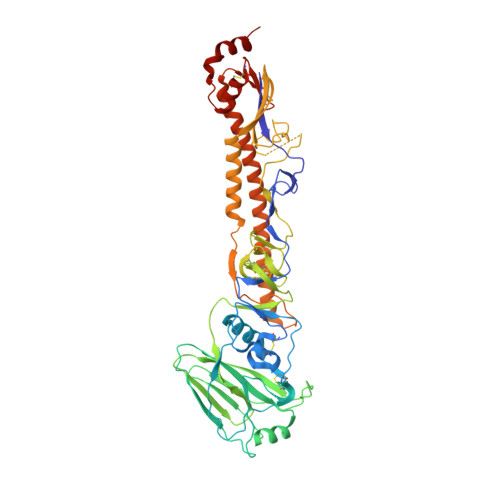Epistasis mediates the evolution of the receptor binding mode in recent human H3N2 hemagglutinin.
Lei, R., Liang, W., Ouyang, W.O., Hernandez Garcia, A., Kikuchi, C., Wang, S., McBride, R., Tan, T.J.C., Sun, Y., Chen, C., Graham, C.S., Rodriguez, L.A., Shen, I.R., Choi, D., Bruzzone, R., Paulson, J.C., Nair, S.K., Mok, C.K.P., Wu, N.C.(2024) Nat Commun 15: 5175-5175
- PubMed: 38890325
- DOI: https://doi.org/10.1038/s41467-024-49487-4
- Primary Citation of Related Structures:
8FAQ, 8FAW - PubMed Abstract:
The receptor-binding site of influenza A virus hemagglutinin partially overlaps with major antigenic sites and constantly evolves. In this study, we observe that mutations G186D and D190N in the hemagglutinin receptor-binding site have coevolved in two recent human H3N2 clades. X-ray crystallography results show that these mutations coordinately drive the evolution of the hemagglutinin receptor binding mode. Epistasis between G186D and D190N is further demonstrated by glycan binding and thermostability analyses. Immunization and neutralization experiments using mouse and human samples indicate that the evolution of receptor binding mode is accompanied by a change in antigenicity. Besides, combinatorial mutagenesis reveals that G186D and D190N, along with other natural mutations in recent H3N2 strains, alter the compatibility with a common egg-adaptive mutation in seasonal influenza vaccines. Overall, our findings elucidate the role of epistasis in shaping the recent evolution of human H3N2 hemagglutinin and substantiate the high evolvability of its receptor-binding mode.
Organizational Affiliation:
Department of Biochemistry, University of Illinois Urbana-Champaign, Urbana, IL, 61801, USA.

















